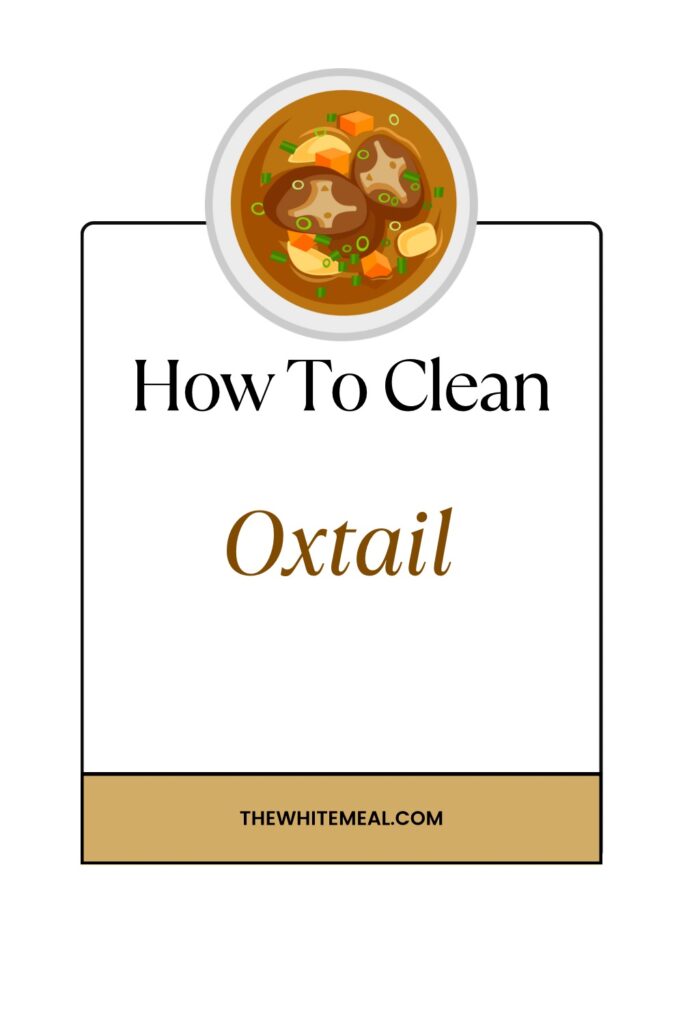While many are unfamiliar with oxtail, this modest cut of meat is a culinary treasure that stars in hearty soups, robust stews and slow-cooked braises.
Its rich flavor profile is only matched by its cost-effectiveness; however, the full potential of oxtail can only be released with proper cleaning.
In this feature, we delve into the art of correctly cleaning oxtail, thus ensuring any remaining dirt particles, excess fat or unwanted bacteria are effectively removed.
Also on our menu for discussion is the value-adding processes of marinating or brining your oxtail.
These techniques don’t just add a layer of flavor to your dish but elevate it to an entirely new dimension.

Should Oxtail Be Washed Before Cooking?
Many might question the preparatory steps before cooking oxtail, specifically regarding whether or not it should be washed.
The answer isn’t black-and-white, as the primary concern circles around issues of cross contamination.
It is generally not necessary (and recommended) to wash “all types of meats”, especially poultry prior to cooking due to the risk of spreading bacteria throughout the kitchen – a concern that’s shared by many culinary experts and food safety authorities.
However, an exception may be made for oxtail or any time of meat if there is visible dirt on it.
In such cases where oxtail needs a good rinse, it must be done in a controlled manner.
This means washing it carefully under cold running water inside a clean sink, followed by immediately sanitizing any areas which came into contact with the raw meat.
Regarding the familiar query of why one should not treat oxtails differently from other meats when it comes to washing – it boils down to hygiene and food safety standards.
Washing your oxtail will not necessarily make it cleaner or safer; in fact, improper washing can have quite the opposite effect by inadvertently causing cross contamination.
The bottom-line here? If your oxtail looks clean and devoid of visible dirt particles, skip the washing process and proceed directly to soaking in vinegar, marinating or seasoning as you would normally do.
Why Do You Soak Oxtail In Vinegar?
A number of home cooks and professional chefs swear by soaking oxtail in vinegar, but do you know why?
Many are blissfully ignorant of this practice, or view it as an optional step. However, there’s more to this culinary trick than meets the eye.
Soaking oxtail, or any meat for that matter, in vinegar serves dual purposes – it removes impurities and tenderizes the meat. Imagine the dust particles from cutting bones or an excess of undesirable fatty compounds hidden within the oxtail. With a simple vinegar bath, these unsavory elements are whisked away.
Vinegar also has antibacterial properties, meaning it can effectively kill off harmful bacteria that might be lingering on your meat.
This extra safety measure ensures you’re cooking with the cleanest possible ingredients.
Moreover, vinegar acts as a natural tenderizer, breaking down muscle fibers to give that melt-in-your-mouth texture we all crave when it comes to slow-cooked meat like oxtail.
But remember folks – while these reasons make a solid case for soaking your oxtail in vinegar before cooking, it’s not mandatory.
Some prefer their oxtail just the way it is without this preparatory step. Food is subjective and every palate unique!
So whether you choose to use this old-school technique or not, you’re now armed with the know-how behind this culinary tradition.
How Do You Soak Oxtail In Vinegar, And For How Long?
To prepare your oxtail with a vinegar bath, follow these straightforward steps:
1. Get your hands on a clean bowl or pot large enough for your oxtail cuts.
2. Fill the bowl with cold water until the oxtails are covered.
3. Add a few tablespoons of vinegar — plain distilled white is best.
4. Place your pieces of oxtail in the vinegary water.
5. Let them soak for 8 minutes – no longer as you don’t want to start cooking the meat :)!
After soaking, take out the pieces of oxtail and pat them dry using paper towels or a clean dishcloth.
That’s all there is to preparing your favorite cut!
What Other Way Can You Use To Remove Impurities In Oxtails Aside From A Vinegar Soak?
Popularly, vinegar soaking has been the go-to method for cleaning cuts of oxtail. But did you know there’s another efficient and equally effective way that sidesteps the use of vinegar altogether?
Throw out that vinegar because we’re diving into boiling, a technique as old as cooking itself!
Boiling your oxtail for about 15 minutes is a foolproof method to rid the meat of any impurities that might be hiding within its nooks and crannies.
Here’s why it works. Just like how water turns to steam under intense heat, impurities likewise cannot withstand high temperatures and will separate from the meat during the boiling process.
Impurities float to the surface, making them easy to scoop out or strain off.
Yes, it’s that effortless!
Aside from being an effective decontamination approach, boiling your oxtail offers an added bonus: It aids in tenderizing the meat.
Post-boil oxtails tend to be subtly softer than their raw counterparts, which could cut down your overall cooking time.
How Do You Remove Fat From Oxtails
Oxtails are a unique cut of meat known for their rich bone marrow, gelatinous texture and deep flavor.
However, they come with a fair amount of fat, which some people might find overwhelming.
To trim the fat off the oxtail, you’ll need a sharp chef’s knife and a bit of patience.
Simply put, you want to carefully skim your knife along the fat-laden areas with precision and caution.
Yes, you could be dealing with rather hardy chunks of fatty parts here, which means careful maneuvering is key to ensuring that only excess fat is removed while preserving those delicious meaty bits.
Remember that your mission isn’t to completely denude these tail sections.
A smidgen of fat enhances flavor and contributes towards creating that luscious mouthfeel so characteristic of well-prepared oxtail dishes.
It’s all about striking the right balance.
But by trimming off excess fat prior to cooking, you ensure yourself a less greasy end result while still enjoying every bit of sumptuous goodness oxtail promises.
How To Brine (or marinate) Oxtails
To truly unlock the full potential of oxtails, you need to understand how to properly brine or marinate oxtails.
Oxtail is simply the tail of a cow, with meat that is rich in collagen and packed with flavors.
This can be further amplified through the process of brining or marinating.
But wait! What does brining mean?
And how is it different from marinating?
Brining is the process of soaking any meat in a solution of salt and water for hours or even days before cooking. This is done so as to tenderize and moisten the meat by osmosis.
Marinating, on the other hand, involves immersing oxtails in a mixture of spices, herbs and other flavor-enhancers like wine or citrus juices.
The oxtail absorbs these flavors while also becoming tenderized over time.
How To Brine Or Marinate Your Oxtails?
To get started with either process, first clean your oxtails thoroughly.
Then if you’re brining, dissolve about a cup of salt in a gallon of water (you can adjust these quantities depending on the size of your oxtail).
Immerse your oxtail pieces into this solution and let them rest in your fridge for about 24 hours.
On the other hand, if you’re marinating, prepare your marinade mix by blending together aromatic herbs like thyme and rosemary with garlic cloves, onion slices and black pepper.
Add some sauce like soy sauce or Worcestershire sauce if you’re feeling adventurous.
Pour this mix over your oxtail in a sealable container and ensure all pieces are well-coated before placing it back into your fridge for 6-36 hours.
Either way you choose to go about it – brining or marinating – remember that patience is key here.
Once done properly and paired with slow cooking methods such as braising or stewing, your oxtails will turn out tenderized, well-flavored and totally irresistible.

